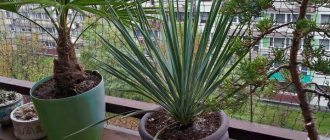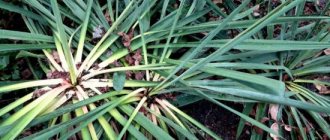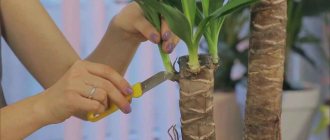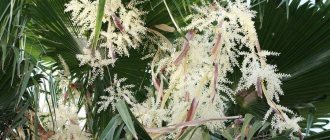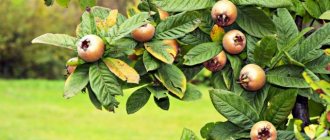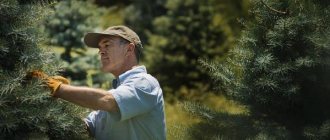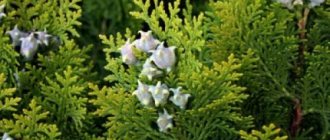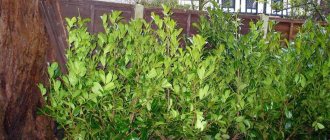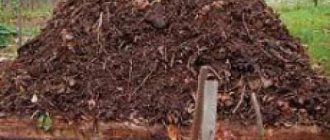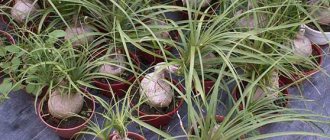Yucca garden is a close relative of the popular indoor plant. But if in potted culture its unusual, stylized “palm tree” shape is valuable, the street counterpart is interesting for its chic inflorescences up to one and a half meters long and half a meter in diameter. A fascinating sight!
Previously, the flower was cultivated mainly in the south, but now it can also be found in the gardens of the middle zone, where it forms truly “heavenly thickets.” We decided to figure out how difficult it is to care for a resident of semi-deserts, how to help her adapt to the Russian climate and preserve her in the conditions of a frosty winter.
Each yucca inflorescence contains 200–250 bells, which remain decorative for 1.5–2 months
Description of the plant
In its natural environment, yucca is found in Central and North America and Mexico. There are about 20 species of plants that can winter in open ground in subtropical climates. In Russia, yucca is planted in city squares and parks on the Black Sea coast.
The Yucca plant belongs to the Agave family. This is a tree-like perennial shrub, classified as an evergreen. It has hard sword-shaped leaves that grow in a spiral, forming a kind of rosette.
The leaves are plate-like and glaucous or green in color and can grow up to one meter.
In the center of the rosette rises a peduncle in the form of a huge panicle. It bears drooping flowers that are white or yellowish in color.
One inflorescence per season can produce up to 200 bells, the length of which reaches 7 cm, and the diameter up to 5. At the end of flowering, a fruit with seeds is formed. During the flowering period, the plant looks very attractive; the flowers attract many pollinating insects.
Popular varieties of street yucca: description and characteristics
Before planting this flower outside, you need to choose the right variety. There are several types of yucca that have certain characteristics.
filamentous
This culture comes from North America. It is a stemless bush whose long leaves grow directly from the roots. During the summer, shoots appear on the roots, which are used for propagation. The plant is resistant to frost, but it is recommended to cover it for the winter.
Gray
This plant is native to the western regions of America. This variety of yucca has a low stem. Dormant buds are located on it. Their growth begins when the leaves collected in a bunch die. The inflorescences of the culture reach 1 meter in height. They are covered with a large number of white bells.
Types of garden yucca
In the vastness of Russia, two types of plants are grown in open ground.
Yucca Sizaya
The plant has a short trunk and long leaves, growing up to 90 cm in length. The leaves are thin, have grayish-green leaves with a light stripe along the edges. The flowers of the plant have a yellowish or white with green tint, the inflorescences are narrow and finely branched.
The peduncle can reach three meters. The plant is unpretentious to soil and can grow well in sand.
Tolerates winter frosts and summer drought well. But it can die from excessive dampness.
Yucca filamentous
This is a bush that has almost no trunk, with sword-shaped leaves that grow up to 70 cm. Their width can be from 3 to 10 cm. Their edges are framed by noticeably protruding threads, their top is slightly bent.
The panicle of the peduncle protrudes 2.5 m, strewn with beige-white drooping bells.
The plant is completely unpretentious and can withstand frosts down to 20 degrees.
Most yucca species can only grow in tropical climates. Some species throw out giant flower stalks reaching a height of up to 10 m.
Yucca filamentosa. Video:
Features of care
Caring for an exotic plant is not difficult. Basically, all care consists of watering, loosening, fertilizing, protecting from frost and diseases.
The false palm tree should be watered as the top layer of soil dries. Moreover, yucca leaves should be sprayed daily in the early morning and late evening, in the absence of sunlight.
The plant is not capricious at all. Yucca needs to be watered, fed and protected from frost on time. If all three conditions are met, she will delight you with her attractive appearance.
False palm is relatively resistant to diseases. But prevention should be carried out. The leaves should be wiped from time to time with a cotton pad soaked in vodka. This event will prevent the occurrence of certain diseases.
The main thing in care is not to overdo it with watering; if you water too often and abundantly, the root system may rot. If it is too rare, the leaves of the false palm will begin to curl. Therefore, it is necessary to find a middle ground.
Adult yucca needs to be pruned. Thus, the plant can be rejuvenated and several more seedlings can be obtained from it for planting; pruning should be done immediately after being released from winter insulation.
After trimming the stem, new buds will begin to open, which will become rosettes of leaves. Thanks to this procedure, the plant becomes even more exotic.
Proper pruning of yucca should be done as follows:
- Two days before pruning, the false palm tree should be watered generously.
- Circumcision is performed with a clean, sharpened blade or knife. Approximately 7-9 cm from the level of the rosette of leaves.
- After trimming, wait 10-15 minutes for the trunk to dry. After that, treat the cut with fungicide and crushed charcoal.
- Cover the top with garden varnish.
After two weeks, new shoots will appear. A healthy plant has about 5-6 of them.
Yucca garden: care and replanting
If you want to improve your dacha area by planting yucca, it is recommended that you familiarize yourself with the features and rules of planting.
Preparing for transplant
You need to buy yucca for planting at a specialized flower shop. This way you can avoid purchasing a non-varietal plant. It should not be planted immediately in open ground - it is better to harden it first.
To do this, you need to take the pot with the plant out for two weeks, first for 1-2 hours, and then increase the time spent outside.
It is recommended to plant yucca in a lighted area with elevated terrain. The plant should not be planted in low areas or in shaded corners.
If a plant is in the shade for a long time, it loses its visual appeal - the leaves become thinner, change color, and the trunk becomes thin and elongated.
It is unpretentious to the composition of the soil - it is enough that it is loose, easily ventilated and does not retain moisture. If the soil in the flowerbed where it was decided to plant the plant is dense, you need to add sand to it.
A drainage layer of gravel should be placed at the bottom of the hole, and if the soil is poor (there is a lack of useful vitamins and minerals), humus should be added.
Yucca does not tolerate drafts, especially in cold weather. Therefore, it is better to choose a site protected from the wind.
How to plant yucca?
For small seedlings, you need to dig small holes. But it is necessary to take into account that the yucca flower will grow. But a 3-year-old yucca needs to be planted in a hole with a diameter of 70-100 cm. The root of the plant needs to be buried 40-50 cm.
Place the plant with straightened roots at the bottom of the hole, sprinkle with soil and lightly press it down with your hands. Immediately water the plant with warm water.
Many people are concerned about the question: when to transplant garden yucca into open ground?
It is best to carry out this process in the spring, when at night the thermometer stops dropping below +10 degrees.
It is recommended to wear gloves when working with the plant to avoid injury from the sharp edges of the leaves.
Watering and fertilizing
Caring for yucca is not burdensome. After transplanting, regular watering is required, but not frequent. It is also necessary to fertilize with fertilizers.
It is necessary to water the plant after the soil has completely dried. If the leaves wither and dry out, the flower must be sprayed with water. This procedure should be performed in the evening or early in the morning. In hot weather, the leaves can get sunburned.
In summer, the plant needs to be fed with complex mineral fertilizer for succulents.
This is done only twice - the first time in May, at the beginning of the growing season, and the second time when the yucca fades.
When and how does yucca bloom?
Often, yucca planted in open ground fully blooms only in the third season. If you care for the plant, under good weather conditions, flowers may appear the next year. Flowers decorate a discarded panicle for a short time - 2-3 weeks, in rare cases a month.
In order for yucca to bloom for a long time, it requires moderate watering and regular feeding, as well as a lot of light and pleasant warmth.
Weeding and loosening the soil
These are mandatory procedures for any garden plant. Yucca needs loose, breathable soil for normal “breathing” of the root system.
If you exclude the appearance of an earthen crust and compaction of the top soil, the plant will withstand the winter cold well and will bloom luxuriantly in the summer.
Yucca does not pay attention to small weeds, but large plants need to be weeded in time. You can carry out mulching - scatter stone chips or decorative material around the trunk.
Plant pruning
In the southern regions, gardeners form a bush by removing the lower leaves.
In the middle zone, pruning yucca comes down to timely removal of the peduncle and leaves that have dried out over the winter.
When the inflorescences begin to turn brown, the peduncle is cut off with a clean and sharp tool at an angle to the very base. After wintering or replanting, all dry and wilted leaves must be removed.
To form new rosettes and, if you want to make the planting more massive, you need to cut off the main peduncle. This can promote the formation of new lateral processes and new rosettes.
Yucca transplant
When yucca is planted in a good place, it can live on it for up to 20 years. If the place is uncomfortable for it, it would be better to transplant it to another part of the site. It is better to replant the plant when it is less than three years old. Then it will settle in well and painlessly.
The huge, overgrown bush also needs replanting. But such plants may die after the procedure.
The presented procedure must be carried out in spring or late summer. Carefully dig up the roots without damaging them. In this case, it is necessary to separate all shoots from the rhizome; they are planted separately. After two weeks, the plant is fed.
Transplanting yucca in the fall is undesirable. The disturbed root system is not able to recover by winter and simply will not tolerate the cold. Therefore, it is better not to touch the yucca in the fall, but provide it with care to preserve the plant until spring.
How to care for homemade yucca?
Yucca is able to enliven even the most meager, spartan interior, introducing notes of exoticism. That is why this particular plant is often chosen to decorate office and other non-residential premises. And in an apartment setting, the beautiful palm tree does not go unnoticed, especially since yucca at home does not require complex care and does not have any special climatic preferences.
However, the plant is still exotic and the owner should pay special attention to some points:
Lighting and suitable location
All yuccas love light, so it is recommended to place containers with palm trees closer to the windows, on the east or west side. If you position your pet correctly and provide it with plenty of sunlight, the yucca will grow and develop well.
When the plant is located near a south window, it is advisable to protect it from the scorching midday sun by using a thin curtain or blinds. Young specimens feel good on the windowsill.
In winter, light-loving yucca may lack natural light, so you should think about additional artificial light. Special phytolamps are best suited for this. The plant feels more comfortable with 10-12 hours of daylight.
In the summer, it is advisable to take the false palm tree out into the air, but avoid drafts and direct sun.
Temperature
In summer, the plant is suitable for normal room temperature - from +22 to +26 degrees. In winter, it is recommended to lower the indicator to +16 - +20 degrees.
During operation of heating devices, the palm tree may suffer from exposure to hot air - stretch out, lose the turgor of the foliage. Regular ventilation and covering the radiators will help your pet; a good solution is installing a split system. When ventilating the room, the plant should be removed to an adjacent room.
Indoor air humidity
The average value of 40-50% is quite suitable for these plants, which is why they grow well in an ordinary apartment. Additional humidification of the air in the room is not required. Unless during the heating season you can periodically irrigate the yucca leaves from a spray bottle. It is only important that the moistened leaf blades are not exposed to bright sun, as it can burn them.
It is also recommended to clean the yucca foliage from dust and dirt with wet wipes.
How to water yucca?
The irrigation regime depends on various factors - the season, air humidity, the size of the palm tree and the tank in which it grows. A young, newly acquired specimen needs daily soil moisture. Moisture is added in small portions.
An adult plant is watered once every 2-3 weeks, usually this is done when the top layer of soil dries 5-7 cm deep. The water should be at room temperature or a little warmer, and must be settled. In autumn and winter, the amount of watering is reduced, especially if the palm tree is cool.
Experienced flower growers note that for a 5-liter container, 1 liter of water is enough for one watering. The yucca will survive drying out, but too much sweat can lead to rotting of its roots and subsequent death. Any moisture that has accumulated in the pan should be removed.
In hot weather, you can give your exotic pet a shower by first covering the soil with polyethylene. To dry it should be placed away from drafts and direct sun.
Fertilizer application
During the active growing season, from mid-spring to the end of summer, yucca needs to be fed. This should be done 2 times a month. Mineral solutions that are diluted in more water than recommended in the instructions are best suited for this.
You can spray the underside of the foliage with fertilizer; the false palm will like this procedure. The application of foliar fertilizers is alternated with watering the plant.
Sick, newly transplanted, and resting palm trees in the autumn-winter period do not need feeding. If a nutrient substrate was used as soil, then the yucca will do well without additional fertilizers throughout the year.
Soil quality
A light, loose, but nutritious soil mixture is suitable for these plants. You can prepare it yourself by taking leaf soil, turf, peat, humus and coarse river sand in equal proportions.
You can also plant yucca in store-bought soil intended for palm trees or dracaenas. It should be slightly acidified or neutral. When preparing it yourself, it is recommended to disinfect the soil mixture - bake it in the oven for an hour and a half or freeze it.
Pruning false palm
This procedure is required for yucca for several reasons: firstly, for rejuvenation, and secondly, to give it a neat decorative shape. For example, branches are cut off if the plant is overly elongated. But, you should leave a couple of buds, which are growth points. The cut parts are suitable for further rooting.
Old, dried, damaged leaves also need to be removed. It is advisable to plan the event for the spring, but the beginning of the active growing season. Instruments are pre-disinfected with an alcohol solution.
How to preserve a plant in winter?
Yucca filamentous and glaucous are frost-resistant plant species. They tolerate temperature drops down to -20 degrees very well. Young plants must be covered in the first two years.
The same must be done in places with harsh climatic conditions. Insulation can be done in two ways.
First way
Work must be done in dry weather.
Here you need to collect all the leaves in a bunch and tie them along the entire length with twine. To prevent the ground around the outlet from freezing, spread the bottom layer of leaves on the ground.
Cover them with dry leaves of other plants and weigh them down with boards or sticks to prevent them from being blown away by the wind. Wrap the tied sketches in polyethylene and cover the base of the trunk with dry soil.
Second way
Build a wooden box according to the dimensions of the yucca bush and cover the plant with it. Insulate the top of the box with roofing felt, foam plastic or other similar material. Cover the entire structure with straw or spruce branches. To prevent the insulation from being blown away by the wind, wrap it with film.
The insulation procedure must be carried out at the end of October or beginning of November. Yucca can be freed from captivity in the spring, when the night frosts have ended.
Yucca propagation
Yucca garden can be propagated in several ways:
- cuttings;
- seeds;
- stem;
- dividing the bush.
The easiest way is the last one. It is carried out during transplantation of an overgrown bush in the spring.
When asking how to plant yucca, follow the following sequence:
- It should be carefully dug up and the sprouts should be separated along with shoots and roots. The root system of the plant goes deep into the ground, so you need to dig deeper so as not to cut the rhizomes.
- Then each seedling is planted in a permanent place and watered.
- Caring for it is the same as for a regular bush.
If you decide to grow yucca from a stem, you must:
- Trim the trunk just above the rhizome and dry it a little.
- Then you need to plant it in the sand, laying it horizontally.
- Leave the stem in a warm place and keep the sand moist.
- When roots appear, cut the stem into pieces and plant all the pieces separately.
Cuttings require cutting the stem at the very top. It should have leaves. Dry the cuttings and then place them in a pot with sand or perlite. Keep the substrate moist by spraying periodically.
To propagate yucca seeds you need:
- Collect seeds at the end of August from a faded plant or buy in a store. The seeds are round in appearance, the diameter reaches 5-10 mm.
- Sow the seeds in a container with soil consisting of equal parts of leaf soil, turf soil and sand. Shoots appear after a month.
- When the first two leaves come out, you need to drop them into separate cups. Only when the bushes have grown and become stronger can they be planted in open ground.
Such plants can bloom only in the third year, so you should be patient and not do unnecessary steps in caring for the bush.
Yucca or false palm
Plants from exotic countries have taken root quite well in our latitudes, and now their presence in the home or office is not surprising. The most attractive species are those that do not require special care and formation during the growth process. Such plants include yucca or, as it is also called, false palm.
The flower was brought from Central America, and received its name for its external resemblance to a palm tree. When growing yucca, you do not need to spend a lot of time caring for it and do not need frequent watering. The plant prefers a moderate amount of moisture in the soil and at the same time has a positive effect on the air in the room: it removes contaminants.
In earlier periods of human history, the false palm was used as a raw material for making clothing, soap and other items. The flower was also called Adam's needle, a Spanish dagger.
Yucca prefers to be in the light and warmth. The ideal option for its placement would be a window facing south. The plant tolerates dry climates well, which means it does not need to be over-watered. It is necessary to moisten the soil only when it is noticeably drying out. Spraying of leaves is carried out up to 2 times a week. The most important condition for the successful growth and development of yucca is the correct planting and composition of the soil. Based on this, before starting the procedure, you should carefully study the requirements and strictly follow them.
Read also: Is it possible to freeze tomato paste in the freezer?
Pests and diseases
Yucca is not afraid of various pests and infections.
Usually it is attacked by aphids if there are aphids in the area on neighboring plants. It is eliminated with infusions of herbs, a solution of laundry soap, wiping all the leaves and inflorescences with it. Insecticides can also be used.
Pests that are dangerous for it are: scale insects, mealyworms and spider mites. But with good care and normal growing conditions, infection and attacks are very rare.
If a plant is attacked by insects, white or brown spots appear on the leaves, it becomes lethargic and stops blooming.
At the first signs of damage, you should wipe the leaves and treat the entire plant with a complex insecticide.
Among the diseases, the most dangerous are considered to be lesions of various types of fungus - rotten spots form on the leaves, the stem becomes soft. It is necessary to cut off the affected areas of the leaves, treat the soil around the trunk and the plant itself with a fungicide.
Pay attention to this material - Garden balsam: planting and care, growing from seeds.
Preparing soil and fertilizers
Yucca is unpretentious, but it will look much more attractive if planted in loose soil that does not retain water. It is advisable to add coarse sand to the soil when planting. The soil must be well drained.
Before planting yucca, it is advisable to dig up the soil in advance and clear it of various weeds. Dig deeply, while simultaneously introducing mineral fertilizers to deeply nourish the soil. It’s a good idea to add black soil or calcareous soil to the soil before planting.
Fertilizing is carried out during the period of active growth, namely: in spring and early summer. At this time, liquid humus, compost and mineral fertilizers will be required.
In the first years of life in the garden, yucca needs to apply mineral fertilizers. They do this for two years. Upon reaching the age of 3 years, they begin to fertilize with organic fertilizers. It is not recommended to feed a bush under the age of 3 years with them; at this time, its root system is not yet strong enough.
Yucca, which is already more than 3 years old, is fed with liquid organic fertilizer in early April.
To develop the vegetative system, in early June, it is necessary to sprinkle a handful of superphosphate on the top layer of soil around the plant. The fertilizer will penetrate the soil when watering or with rain and reach the roots.
